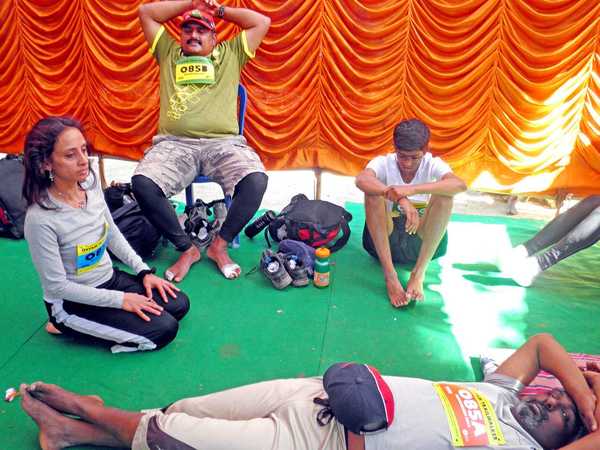On Saturday, January 26th, I completed the Oxfam Trailwalker for the second successive year. A start to finish 100-km walk by teams of four, it offered me quality time for reflection, 32 hours to be precise.
Oxfam India Trailwalker is a team challenge organised to raise funds for Oxfam India, the 61 year old NGO, for its activities that fight poverty and injustice. Our member teams walk (or run) 100 km in less than 48 hours, it is a test of physical endurance requiring mental strength and team spirit.
The Second Oxfam India Trailwalker took us through a 100 km trail from the picturesque Pearl Valley, Anekal to Eagleton, Bidadi off Bengaluru. We had pledged to collect Rs.100,000 from our friends and relatives for Oxfam’s funding activities, and reached 83% of our target before we started the walk. We have time now to exceed our target.
Among the many thoughts that came up during the walk, some related to the concept of Trailwalker itself. A couple of days later, it struck me that some of these observations could be extended beyond the Trailwalker and with some poetic liberty, stretched to a much larger canvas.

Happy walkers team on trail
Listening to the many snippets of conversation along the trail, I could discern three or four clear motives in the walkers. Many who had considered themselves older, unfit or on the heavier side, were walking to prove to themselves that they could do it. A few had been spurred into action by wagers too.
A race to complete within the shortest time was seen among some. Among a discerning few, the desire to enjoy the experience and deepen the bonds within team members was prominent, completion time being only a by-product.

Local cheer leaders, children at check point 1, at Binnamangala.
As I look back, my own motive the first year was to prove to myself that we could do it. This year to a large extent, it oscillated between improving our timing and enjoying the journey. Hopefully next year, I can fully focus on enjoying the experience of the 100-km walk, relishing each and every kilometre and deepening the bond among team members.
Secondly, what I saw as an act of physical endurance soon turned into a test of mental strength. For the physically stronger, the mental test was less intense, but nevertheless present. Last year my mind had to be called into play on the second day with 50% of the distance to go, whereas this year, I used physical strength for almost 80% of the journey, before shifting gears.

Food service by AWAKE.
A counterintuitive fact I noticed was that the older team members seemed to be coping with the challenge a lot better than the younger ones. This became more evident as the journey progressed. Could it have any linkage with my earlier point, or does it reflect bias, a product of my grey hair?
Even in the most cohesive and well-matched teams, some members were stronger or faster than others. Keeping the team together was the sole prerogative of the strong and the fast, for the weaker /slower members could do little to catch up with them despite their deep desire to do so.

Happy walkers team resting at checkpoint 4.
Darkness knit the teams tightly. Spatially the distance between the four team members closed down sharply during the night in contrast to day time when the teams were more widely spread out. Even though there was no danger lurking around in the dark, the apprehension of it was enough to keep the team tightly knit.
Crisis promoted bonding in the team. It could be any crisis – an injury, blister or being chased by a stray dog. The need for help by one and response by another provided an opportunity for the two to share experiences beyond the present by delving into their past which strengthened the bond.
Women I believe are much more resilient than men. While I always had this idea somewhere at the back of my mind, during Trailwalker, it came to the forefront on many occasions. After sustaining injury (more often than not it was blisters on their feet), most men tend to leak confidence and look for support and reassurance. In contrast, many women strengthened their resolve and looked ahead with purpose.
While I would like to believe that in a non-competitive event such as Trailwalker there would be fair play and no cheating, I was sadly disappointed. A handful cheated. They travelled by car for short distances when they should actually have been walking. I do not know their motive for walking, but I wonder how they could have realized their goal.
Many villagers were puzzled by the sight of tired walkers on foot and cars driving through without passengers as they wondered aloud at this foolishness. I could not explain this puzzle to the bewildered villagers.
The joy on completion was something I cherished. When I listed the top 10 events in my life for 2012, Trailwalker was one of them. For 2013, have I notched up the first?⊕